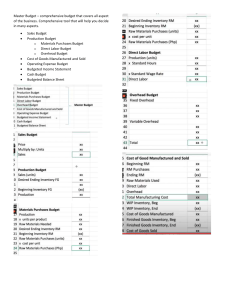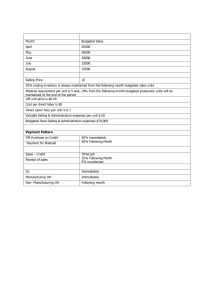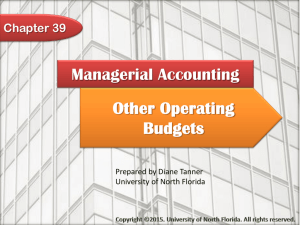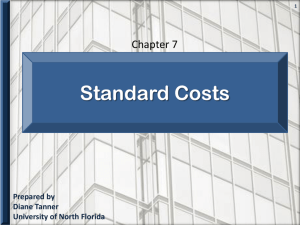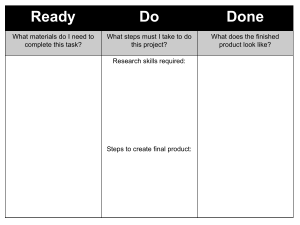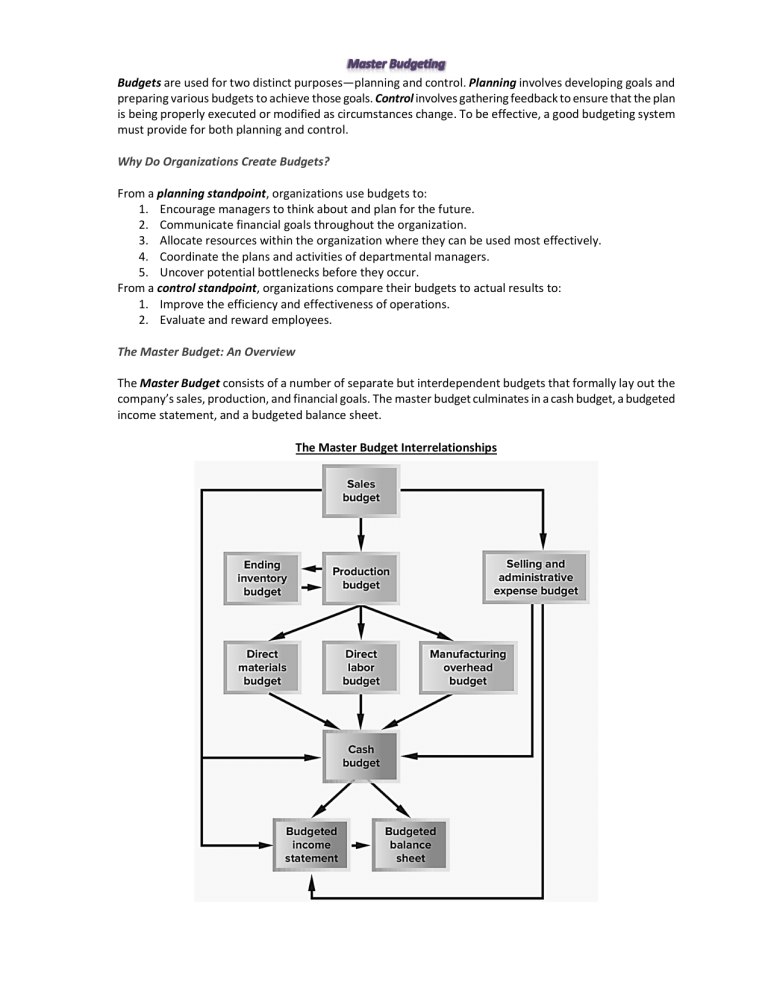
Budgets are used for two distinct purposes—planning and control. Planning involves developing goals and preparing various budgets to achieve those goals. Control involves gathering feedback to ensure that the plan is being properly executed or modified as circumstances change. To be effective, a good budgeting system must provide for both planning and control. Why Do Organizations Create Budgets? From a planning standpoint, organizations use budgets to: 1. Encourage managers to think about and plan for the future. 2. Communicate financial goals throughout the organization. 3. Allocate resources within the organization where they can be used most effectively. 4. Coordinate the plans and activities of departmental managers. 5. Uncover potential bottlenecks before they occur. From a control standpoint, organizations compare their budgets to actual results to: 1. Improve the efficiency and effectiveness of operations. 2. Evaluate and reward employees. The Master Budget: An Overview The Master Budget consists of a number of separate but interdependent budgets that formally lay out the company’s sales, production, and financial goals. The master budget culminates in a cash budget, a budgeted income statement, and a budgeted balance sheet. The Master Budget Interrelationships 1. Sales Budget: The first step in the budgeting process is preparing a sales budget, which is a detailed schedule showing the expected sales for the budget period. An accurate sales budget is the key to the entire budgeting process all other parts of the master budget depend on the sales budget. If the sales budget is inaccurate, the rest of the budget will be inaccurate. The sales budget is based on the company’s sales forecast, which may require the use of sophisticated mathematical models and statistical tools that are beyond the scope of this course. The sales budget influences the variable portion of the selling and administrative expense budget and it feeds into the production budget, which defines how many units need to be produced during the budget period. The production budget in turn is used to determine the direct materials, direct labor, and manufacturing overhead budgets. Once a company has prepared these three manufacturing cost budgets, it can prepare the ending finished goods inventory budget. 2. Cash Budget: The master budget concludes with the preparation of a cash budget, income statement, and balance sheet. Information from the sales budget, selling and administrative expense budget, and the manufacturing cost budgets all influence the preparation of the cash budget. A cash budget is a detailed plan showing how cash resources will be acquired and used. The budgeted income statement provides an estimate of net income for the budget period and it relies on information from the sales budget, ending finished goods inventory budget, selling and administrative expense budget, and the cash budget. The final schedule of the master budget is the balance sheet, which estimates a company’s assets, liabilities, and stockholders’ equity at the end of a budget period. 1. 2. 3. 4. 5. 6. 7. 8. 9. 10. The parts of the master budget are as follow: A sales budget, including a schedule of expected cash collections. A production budget (a merchandise purchases budget would be used in a merchandising company). A direct materials budget, including a schedule of expected cash disbursements for purchases of materials. A direct labor budget. A manufacturing overhead budget. An ending finished goods inventory budget. A selling and administrative expense budget. A cash budget. A budgeted income statement. A budgeted balance sheet. 1. Sales and Cash Collections Budget The foundation and starting point for the master budget. Determines the anticipated unit and dollar sales for the budgeted income statement. May also include a schedule of expected cash collections that determines the amount of expected cash collections from customers for each period based on an expected collections pattern. 2. Production Budget Determines the number of units of finished goods that must be produced each budget period to satisfy expected sales needs (from the sales budget) and to provide for the desired finished ending inventory. Although it is prepared in units of finished goods, the production budget may be used to determine several items on the budgeted financial statements: o Budgeted cost of goods sold by multiplying units sold by cost per unit o Budgeted beginning and ending finished goods inventory by multiplying units in inventory by the cost per unit o Budgeted cost of goods manufactured by multiplying units produced by the cost per unit. 3. Budgeted Cost per Unit Budgeted cost per unit for finished goods produced has three components: direct materials, direct labor and variable and fixed overhead. Each type of cost requires a separate budget in the master budget. Budgeted Cost per Unit Budgeted cost per unit for finished goods produced has three components: direct materials, direct labor and variable and fixed overhead. Each type of cost requires a separate budget in the master budget. 4. Direct Materials Budget Determines the quantity of direct raw materials that must be purchased each period to meet anticipated production needs (from the production budget) and to provide for adequate levels of direct raw materials inventories. Remember that raw materials inventory may also include indirect materials. This budget addresses only the direct materials portion of raw materials inventory. The indirect materials portion is addressed as part of the overhead budget. Production needs are stated in units of finished goods and multiple units of direct materials may be required to produce one unit of finished goods. The first step in the direct materials budget is to convert units of finished goods produced into direct materials needed to produce them by multiplying the number of units produced by the direct materials required to produce one unit of finished goods. The final step in the direct materials budget to to determine the cost of the direct materials purchased by multiplying the quantity to be purchased by the purchase price per unit. May also include a schedule of expected cash disbursements which determines the amount of expected cash payments to suppliers and vendors for each period based on an expected payment pattern. 5. Direct Labor Budget Determines the direct labor hours and direct labor dollars required each period to meet anticipated production needs (from the production budget). The indirect labor costs are addressed as part of the overhead budget. Direct labor budget may be affected by overtime costs, inelastic supply of labor, a minimum number of hours to be worked and other unique requirements. 6. Manufacturing Overhead Budget The manufacturing overhead budget has two components – variable and fixed overhead. Budgeted variable overhead expenses depend on the number of units produced from the production budget and a budgeted variable overhead cost per unit. Budgeted fixed overhead expenses depend on the total cost expected to be incurred for each type of fixed overhead cost. Any noncash fixed manufacturing overhead costs, such as depreciation expense, is deducted from the total manufacturing overhead to determine the cash disbursements for manufacturing overhead. (Remember that depreciation expense is a non-cash expense. The cash was spent when the depreciable asset was acquired and not when the asset is depreciated.) 7. Selling and Administrative Expense Budget Selling and Administrative (S&A) expense budget is similar to the manufacturing overhead budget as it includes variable and fixed expenses. Budgeted variable S&A expenses depend on the number of units sold or sales dollars from the sales budget. Budgeted fixed S&A expenses depend on the total cost expected to be incurred for each type of fixed S&A cost. Any noncash fixed S&A costs, such as depreciation expense, is deducted from the total S&A expenses to determine the cash disbursements for S&A expenses. (Remember that depreciation expense is a non-cash expense. The cash was spent when the depreciable asset was acquired and not when the asset is depreciated.) 8. Cash Budget Cash budget is composed of four major sections: 1. Cash Receipts 2. Cash Disbursements 3. Cash Excess or Deficiency 4. Financing The cash budget uses information from all of the other budgets: cash receipts from the sales budget, cash disbursements from direct materials budget, cash disbursements from the direct labor, manufacturing overhead and selling administrative expense budget. It may also include other sources of cash receipts such as proceeds from the sale of plant assets, issuance of stock or issuance of bonds. It may also include other sources of cash disbursements such as the purchase of plant assets and the payment of cash dividends. The company may also have to meet a minimum balance requirement for its cash account that is imposed by the bank. If the cash balance falls short of the minimum required, the company will have to borrow money to increase the cash balance to the minimum. If the company has cash in excess of the minimum balance required, it is obligated to pay off any outstanding borrowings and the related interest payable. After the borrowings and interest have been paid off, the company may leave the “excess” cash in the cash account. 9. Budgeted Financial Statements Budgeted financial statements are prepared after all of the other budgets, including the cash budget, have been prepared. They serve as a benchmark against which subsequent actual company performance can be measured.
